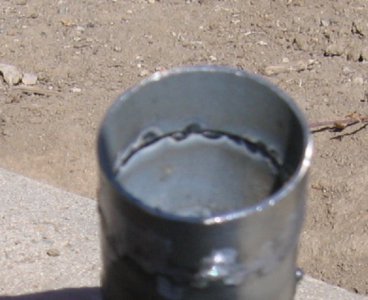- Joined
- Oct 31, 2016
- Messages
- 2,644
My HF 125 has been modified with a bridge rectifier and a capacitor so it is a DCEN welder. I am using 030 wire that came with the machine. Spent most of the afternoon watching videos on flux core welding and practicing welding electrical conduit thin wall steel tubing. It's what I have on hand. Cleaned the conduit to bright and shiny before welding. Tried all kinds of different settings. Min and Max power and wire speeds from 1 to 5. Except when the wire speed was set to 1 I didn't really notice much difference in the welding.
Out of all of the videos I watched only one gave the settings being used. Power on max and wire speed on 5 welding exhaust tubing. He was doing overlapping tack welds. All the rest mentioned adjusting the settings to suit the material. Yet no demonstration on how different settings impacted the weld or the settings being used.
I found that it was real easy to blow a hole in the tubing no matter what the settings were.
First question is power setting. Intuition suggests that you should be using the min power setting when welding thin tubing. But what about penetration? Should I see the weld on the inside of the tubing. Only about half of my tacks looked like they had penetrated all the way through. If you are tack welding would max power be better to get quick penetration without blowing a hole?
How does wire speed effect the weld? Is it dependent on how thick the material is? Or how fast you are welding? Or some combination of the two.
Some of my tacks would be a small flat circle. I think this is what I am striving for. Others would have a dent in the center. What causes this? Others would have a bulge in the center or a bulge around the edges with a deeper dent in the center. What causes this?
Sorry no pictures. They were too blurry to show anything. I'll try again tomorrow.
Thanks for any advice you can share.
Out of all of the videos I watched only one gave the settings being used. Power on max and wire speed on 5 welding exhaust tubing. He was doing overlapping tack welds. All the rest mentioned adjusting the settings to suit the material. Yet no demonstration on how different settings impacted the weld or the settings being used.
I found that it was real easy to blow a hole in the tubing no matter what the settings were.
First question is power setting. Intuition suggests that you should be using the min power setting when welding thin tubing. But what about penetration? Should I see the weld on the inside of the tubing. Only about half of my tacks looked like they had penetrated all the way through. If you are tack welding would max power be better to get quick penetration without blowing a hole?
How does wire speed effect the weld? Is it dependent on how thick the material is? Or how fast you are welding? Or some combination of the two.
Some of my tacks would be a small flat circle. I think this is what I am striving for. Others would have a dent in the center. What causes this? Others would have a bulge in the center or a bulge around the edges with a deeper dent in the center. What causes this?
Sorry no pictures. They were too blurry to show anything. I'll try again tomorrow.
Thanks for any advice you can share.


